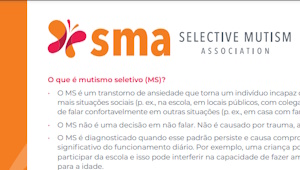Online Library
School-Based Supports for Students with SM: 504 vs IEP Explained
Understanding the Differences Between Section 504 Plans and IEPs
Within the school setting, students with Selective Mutism may qualify for a wide range of supports organized under either a Section 504 accommodations plan or an Individualized Education Program (IEP).
Both 504 Plans and IEPs are rooted in federal legislation and thus have governmental oversight. This means that 504 Plans and IEPs are legal documents that outline the specific supports that a student must be provided at school, in order to support his/her educational progress. While there are some similarities between a 504 Plan and an IEP, such as the fact that both can provide student access to classroom accommodations, there are some important differences as well.
Section 504 Plan Overview
Some students with disabilities are served under Section 504 of the Rehabilitation Act of 1973. Section 504 is a civil rights law that prevents discrimination against any person with a disability at an institution that receives federal funding, including public schools and colleges. The two primary purposes of Section 504 are to remove barriers for students in school, thus allowing them to access their educational environment, and to prevent discrimination against children and adults with disabilities in programs or activities that receive federal funding. Qualification for a 504 plan requires both a diagnosed, or suspected, disability and that this disability adversely impacts a major life activity, such as their educational progress and performance (i.e., academic achievement, behavior, communication, and/or social-emotional functioning).
Generally, 504 plans are most appropriate when a student with a disability requires access to accommodations. Accommodations are minor changes, not to what is being learned, but how the material is being presented (e.g., student provided with both verbal and written directions), how the student is able to demonstrate his/her learning (e.g., student allowed to give oral presentation 1:1 with teacher instead of in front of entire class), how the learning environment is structured (e.g., student allowed to take tests in a small group setting), and the timing of instruction (e.g., student may have access to frequent breaks or extended time on tests).
IEP Overview
The Individuals with Disabilities Education Act (IDEA) is a federal (national) law that requires public schools to provide Free and Appropriate Public Education (FAPE) to students with disabilities. This means that children from birth through the age of 21 who qualify are entitled to receive special education services to meet their needs. The goal is to ensure that students with disabilities are prepared for independent living, employment, and/or further education.
The term, “special education,” often elicits concern and hesitancy from parents, because in past years it has carried some negative connotations. However, “special education” today refers to the process by which children with specific needs who attend public schools receive the support and services necessary to make progress in the general education curriculum. This may include physical needs, social-emotional needs, mental health needs, needs related to learning skill deficits, or others.
Children who qualify for special education services receive a written Individualized Education Program (IEP). An IEP outlines both the accommodations and the specially designed instruction that the student needs in order to access the general education curriculum and make meaningful progress in his/her education. These services and supports are provided by the school at no cost to the parents. One key difference between a 504 Accommodation Plan and an IEP, is that students who qualify for special education services require specialized instruction in addition to accommodations. Specialized instruction is targeted instruction in a specific skill domain in which the student experiences difficulties. For example, a student may receive specialized instruction in reading, math, communication, social skills, or emotional regulation skills. Specialized instruction is often provided by a specialist, such as a speech language pathologist, school social worker, occupational therapist, physical therapist, and/or special education teacher.
Which one is right for my child?
Either a 504 Accommodation Plan or an Individualized Education Plan may be appropriate for students with selective mutism. This decision is made collaboratively, with input from the student, their family, and school staff based on the unique educational needs of the student.
IEP and 504 Plan Comparison
| IEP | 504 |
| Eligibility Determination: Categories of disability under IDEA for which a student can have an IEP include: Autism Hearing impairment Visual impairment Significant developmental delay Emotional disturbance Intellectual disability Orthopedic impairment Other health impairment Specific learning disability Speech or language impairment Traumatic brain injury To qualify for an IEP, the child must be fully and comprehensively evaluated by a multidisciplinary team, facilitated by the school district’s special education services department, and deemed eligible by meeting criteria in at least one of the disability categories listed above. | Eligibility Determination: To be protected under Section 504, a student must be determined to: have a physical or mental impairment that substantially limits one or more major life activities; or have a record of such an impairment; or be regarded as having such an impairment. What is a physical or mental impairment that substantially limits a major life activity? The determination of whether a student has a physical or mental impairment that substantially limits a major life activity must be made on the basis of an individual inquiry. The impairment may be any of various physiological conditions or any mental or psychological disorder that impacts academic achievement, behavior, communication, and/or social-emotional functioning. Major life activities, as defined in the Section 504 regulations include functions such as caring for one’s self, performing manual tasks, walking, seeing, hearing, speaking, breathing, learning, and working. This list is not exhaustive. |
| Services Provided: Students who receive an IEP may be placed in any combination of special education and general education classrooms. The goal of the team is to provide the most appropriate services in the Least Restrictive Environment (LRE). An IEP provides related services, if required, which may include speech and language therapy, occupational therapy, physical therapy, counseling services, psychological services, social services, and transportation. | Accommodations Provided: A Section 504 plan provides students who have disabilities with “reasonable accommodations” dependent on their needs that allow them to participate in the general curriculum at school. Accommodations can include special seating, a quiet place for testing, extra breaks, the use of a computer, different text books, different testing formats, etc. All appropriate accommodations will be established at the 504 Planning Meeting, which you should attend, as well as any subsequent periodic reviews. For a sample 504 Plan for students with Selective Mutism, please see the document 504 Plan Suggestions on the SMA website, at https://www.selectivemutism.org/resources/archive/online-library/school-based-supports-for-students-with-sm-504-vs-iep/ |
| IEP Meeting and DocumentationWhen students are found eligible for special education services, parents/guardians are invited to attend a meeting with representatives from the school district (teacher, special education teacher, school psychologist, appropriate specialists, etc.) to plan an education program that suits your child’s unique needs. This will involve setting specific measurable goals for what you would like your child to accomplish (e.g. reading X number of words per minute) and whatever special education services or accommodations she needs to accomplish those goals. An IEP can include a list of appropriate accommodations, as well as specialized instruction with special education staff members, such as special education teachers, speech-language pathologists, or social workers. Parents are encouraged to work with the school-based team to develop the IEP and many teams work hard to understand SM and develop appropriate goals for students with SM. However, there are certain circumstances where you may wish to bring in a parent advocate, private learning specialist, or special education attorney to the meeting to consult with before signing off on, and thus consenting to the IEP. In all circumstances, parents always have the right to bring an outside person to the meeting for consultation and assistance. IEPs must be reviewed at least once a year, although you can request to do it more frequently. | 504 Plan Meeting and Documentation A meeting will be set up with relevant team members from your child’s school or district. You may wish to bring a sample 504 Plan to generate ideas of what would be helpful for your child. You should bring documentation of your child’s SM diagnosis as being a mental impairment that substantially limits one or more major life activities (as above). |
| IEP Team Members: Child’s parent or caregiver General education teacher Special education teacher School psychologistDistrict representative (e.g., Principal, Special Education Director) Other special education staff, such as the school social worker, speech language pathologist *Students, themselves, can serve as advocates for their own learning and provide important insight into the development of an IEP. Whether or not a student attends the IEP meeting is based on parent/guardian discretion. Parents/guardians and school staff may wish to discuss a variety of factors, such as the developmental age of the student, the student’s comfort level in attending, as well as alternative ways a student may contribute to the development of the IEP. | 504 Plan Team Members: Rules are not as specific about team membership as in an IEP. Individuals familiar with the child are generally included in 504 meetings and may include: Child’s parent or caregiver General education teacher School principal School counselor or social worker *Students, themselves, can serve as advocates for their own learning and provide important insight into the development of a 504 Plan. Whether or not a student attends the 504 Plan meeting is based on parent/guardian discretion. Parents/guardians and school staff may wish to discuss a variety of factors, such as the developmental age of the student, the student’s comfort level in attending, as well as alternative ways a student may contribute to the 504 plan development. |
| • Your child must receive appropriate individualized instruction and is assessed regarding making meaningful progress. | • Only requires “equal access,” not individualization. There is no requirement to monitor your child’s progress. |
| • A parent or caregiver must provide consent in writing for the child to be evaluated by the school. They must also provide consent in writing before IEP services can be implemented once a child qualifies. | •A parent or caregiver is required to provide consent before an evaluation for 504 services can begin. |
| • Your child must be re-evaluated once every three years or sooner if needed or requested by a parent or teacher. | • Requires a “periodic” re-evaluation but the law does not dictate any time frame for that re-evaluation. |
| • Requires an impartial hearing by a neutral hearing officer appointed by the state if parents disagree with the identification, evaluation or placement of the student. | • Provides for impartial hearing. The hearing officer is appointed by the school. Parents can file a complaint with the federal Office of Civil Rights for violations. |
| • Parents must receive ten days’ notice prior to any change in educational placement. | • No prior notice requirement. |
| • Families can request a school district pay for an Independent Educational Evaluation (IEE) by an outside expert. The district does not have to agree. Families can pay for an outside evaluation themselves though school is not required to use this evaluation for making educational decisions. | •Does not allow for families to request the school district pay for an IEE. Families are able to pay for an outside evaluation themselves though school is not required to use this evaluation for making educational decisions. |
What if my child doesn’t attend a public school?
If you choose to send your child to a non-public school, by law, you also give up your right to FAPE, which means that non-public schools are not legally required to provide an IEP or any related services or specially designed instruction. However, some non-public schools will create “service plans” for students with disabilities and may still provide some of the services that students are eligible for in public schools. Contact the non-public schools you are considering for your child and ask what the process is for students with disabilities and what supports and services are available.
Resources
- Wrightslaw: In-depth information on special education law issues. Great for parents, advocates, and attorneys.
- Pacer Center: Resources for families for children with disabilities.
- Individuals with Disabilities Education Act (IDEA): Federal law supporting children in special education.
- Special Education Guide: Guide for parents on the topic of special education.
- Americans with Disabilities Act (ADA): Federal law for 504 accommodations.
- 504 Plan Guide: Guide for parents and educators regarding 504 plans.
- Understood: Articles and resources targeting supports for children who learn differently.
- Office of Civil Rights: Information on your rights and prevention of discrimination.
- https://www.specialeducationguide.com/: Information on learning disabilities and advocacy.




